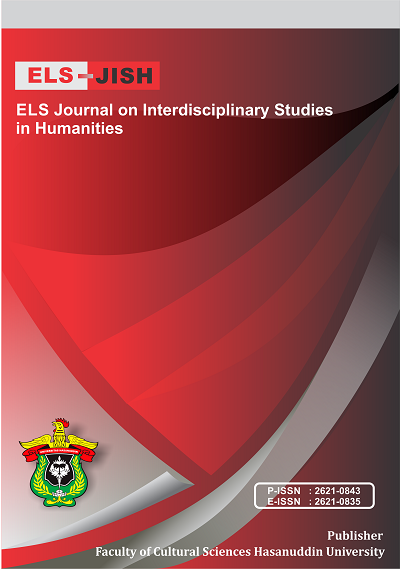A Pragmatic Study of Gestural Strategies in English Political TV Interviews
DOI:
https://doi.org/10.34050/elsjish.v5i3.23125Keywords:
Gestures, Political TV Interviews, PragmaticsAbstract
Part of the substance of an utterance could be represented by gestures. There are many different perspectives on how gestures, words, and cognition relate to one another and how they could influence communication. Gestures are inferior to words because they communicate no semantic information beyond the linguistic utterances that accompany them. The current study aims to find the main gestural strategies, used by the interlocutors in English political TV Interviews that represent speech acts. It is based on the hypothesis that there are different strategies of gestures used by interlocutors in political TV interviews that represent speech acts. The selected interviews have been analyzed in the light of an eclectic model based on model Kulkarni (2013) and Searle (1979). The first is used for analyzing the main kinds of body movements and types of gesticulation, and the latter for analyzing Searle's classification of speech acts since it is a pragmatic study. The results of the selected interviews have shown that gestural strategies are highly related to the context of situation. Each gesture performs a specific speech act. The interlocutors use gestural strategies to express a wide range of emotions, attitudes, approval, anxiety, disagreement, and affection. The participants in these interviews are equally conscious of their body language and verbal exchanges.
References
Adams, Jim W. (2006). The Performative Nature and Function of Isaiah 40-55. New York: T&T Clark.
Allott, N. (2010). Key terms in pragmatics. Bloomsbury Publishing.
Ambady, N., & Rosenthal, R. (1992). Thin slices of expressive behavior as predictors of interpersonal consequences: A meta-analysis. Psychological bulletin, 111(2), 256.
Birner, B. J. (2012). Introduction to pragmatics. John Wiley & Sons.
Calero, H. H. (2005). The power of nonverbal communication: How you act is more important than what you say. Silver Lake Publishing.
Clough, S., & Duff, M. C. (2020). The role of gesture in communication and cognition: Implications for understanding and treating neurogenic communication disorders. Frontiers in Human Neuroscience, 14, 323.
Esposito, A., Bratanić, M., & Keller, E. (Eds.). (2007). Fundamentals of verbal and nonverbal communication and the biometric issue (18). IOS press.
Guan, Y., (2004). Nonverbal communication and college English teaching. Jing Ji Shi, 02, 90-91.
Huang, Y. (2014). Pragmatics. OUP Oxford.
Ibrahim, A. H., Sadkhan, R. M., & Khanfar, A. M. (2021). Silence in Arabic Cross-Cultural Interaction. JELITA, 11-24.
Jing, X., Ping, L., Yanjiao, L., & Othman, B. (2019). The analysis of the pragmatic failures in body language based upon geert hofstede’s cultural dimensions. International Journal of Psychosocial Rehabilitation, 23(2), 816-833.
Kendon, A. (2004). Gesture: Visible action as utterance. Cambridge University Press.
Kraft, H. (2016). Rhetorik und Gesprächsführung, Stuttgart: W. Kohlhammer GmbH.
Kulkarni, D. S. (2017). Homoeopathic management of polycystic ovarian disease: A Case Series study. Materia Novum The Journal of Homoeopathy, 1(3), 14-19.
Lane, S. D. (2016). Interpersonal communication: Competence and contexts. Routledge.
Martinich, A. P., & Sosa, E. D. (Eds.). (2008). A companion to analytic philosophy. John Wiley & Sons.
Mittelberg, I., & Hinnell, J. (2022). Gesture Studies and Semiotics. In Jamin Pelkey & Paul Cobley (eds), Semiotic Movements (Bloomsbury Semiotics 4). London: Bloomsbury Academic.
Natyavidushi, J. (2011). Importance Of Body Language in Effective Multicultural Communication. Annals of the University of Craiova. Series Geography/Analele Universitatii din Craiova. Seria Geografie, 14.
Navarro, J., & Karlins, M. (2008). What everybody is saying: An ex-FBI agent's guide to speed reading people. New York, NY: HarperCollins.
Sahib, H., Hanafiah, W., Aswad, M., Yassi, A. H., & Mashhadi, F. (2021). Syntactic Configuration of Code-Switching between Indonesian and English: Another Perspective on Code-Switching Phenomena. Education Research International.
Sahib, H., & Rahman, F. (2021). Dialogic Speech in Marriage Proposal of Konjonese. In The 2nd International Conference of Linguistics and Culture (ICLC-2) (pp. 105-110). Atlantis Press.
Saleh, N. J., Yassi, A. H., & Rahman, F. (2021). Strategy of Apology in Buginese: A Sociolinguistic Study. ELS Journal on Interdisciplinary Studies in Humanities, 4(2), 188-196.
Searle, J. R., & Searle, J. R. (1969). Speech acts: An essay in the philosophy of language (Vol. 626). Cambridge university press.
Sukmawaty, Rahman, F.F. & Andini, C. (2022). Covid-19 Pandemic and Axiology of Communication: A Study of Linguistic Phenomena. IJISRT, 7(4).
Sukmawaty, S., Andini, C., & Rahman, F. F. (2022). The Shift of Honorifics due to The Promotion As A Government Official: Comparative Study. ELS Journal on Interdisciplinary Studies in Humanities, 5(1), 166-176.
Thomas, J. (1995). Meaning in interaction. An introduction to pragmatics.
Williams, C. (2011). Research methods. Journal of Business & Economics Research, 5, (3), 9-17.
Windayanti, R. R. (2014). Facial Expressions and Gestures of Body Language Analysis of the Male Main Character Jack McCall in a Thousand Words Film 2012. LANGUAGE HORIZON, 2(1).
Yule, G., & Widdowson, H. G. (1996). Pragmatics. Oxford university press.
Downloads
Published
Issue
Section
License
Copyright (c) 2022 Zainab Mohammed Radhi, Atyaf Hassan Ibrahim, Liqaa Habeb Al-Obaydi

This work is licensed under a Creative Commons Attribution-NonCommercial-ShareAlike 4.0 International License.






